Deliciously Moist Lemon Olive Oil Cake: A Gluten-Free & Dairy-Free Delight
Indulge in a slice of pure sunshine with this exquisite **Lemon Olive Oil Cake**, a truly exceptional dessert that seamlessly blends vibrant flavors with a wonderfully satisfying texture. Imagine the bright, zesty tang of fresh lemon dancing with the subtle, rich fruitiness of extra virgin olive oil, all encased in a tender crumb that offers a delightful hint of crunch from cornmeal and ground almonds. This isn’t just a cake; it’s an experience – a gluten-free (or all-purpose flour friendly) and dairy-free option that everyone will adore. Its effortless preparation belies its gourmet taste, making it an absolute crowd-pleaser and my personal go-to dessert for over a decade. Prepare to be enchanted by its irresistible charm and ease of baking!

You might encounter this Mediterranean-inspired delight under various names: a rustic polenta cake, a comforting cornmeal cake, or simply a vibrant lemon cake. The truth is, this recipe brilliantly encompasses all these descriptions, making it a versatile and beloved sweet treat. Its unique combination of ingredients results in a cake that is moist, flavorful, and incredibly satisfying, proving why it has remained a firm favorite in my kitchen for over ten years. Whether you’re a seasoned baker or new to the craft, this easy **gluten-free lemon olive oil cake** recipe promises a delicious outcome every time.
Looking for another simple yet elegant dessert baked in a springform pan? Don’t miss this delightful sweet cherry cake, another perfect treat for any occasion.
[feast_advanced_jump_to]Why You’ll Adore This Lemon Olive Oil Cake Recipe
There are countless reasons why this **moist lemon olive oil cake** will become a staple in your dessert repertoire. From its incredible flavor profile to its sheer simplicity, this cake offers convenience and deliciousness in equal measure. Here’s why you’ll fall in love with it:
- A Guaranteed Crowd-Pleaser: If you’re surrounded by lemon enthusiasts, this cake is an absolute must-make. Its bright, citrusy notes are universally appealing, making it the perfect dessert for gatherings, potlucks, or family dinners. The combination of lemon, almond, and olive oil creates a sophisticated yet comforting flavor profile that will earn you rave reviews.
- Effortless Make-Ahead Option: One of the best qualities of this cake is its ability to be made in advance. Preparing it a day or two ahead actually allows the flavors to meld and deepen, enhancing its rich taste and moist texture. This makes it an ideal choice for entertaining, freeing up your time on the day of the event. Simply bake, cool, and store until ready to serve.
- Incredibly Versatile for Any Occasion: This isn’t just a dessert; it’s a chameleon in the culinary world. Serve it as an elegant end to a dinner party, a delightful treat with afternoon tea or coffee, or even a sophisticated addition to brunch. Its balanced sweetness and refreshing lemon flavor make it suitable for a wide range of serving times and events.
- Dress It Up or Enjoy It Simply: Whether you prefer a minimalist approach or an elaborate presentation, this **almond olive oil cake** adapts beautifully. A simple dusting of powdered sugar is elegant and understated, while a vibrant lemon glaze, fresh berries, or a dollop of whipped cream can elevate it to a show-stopping centerpiece for special occasions.
- Remarkably Easy to Prepare: Don’t let its gourmet taste intimidate you. This recipe is designed for ease, largely thanks to the trusty food processor. This kitchen workhorse handles all the grinding and mixing, significantly cutting down on prep time and effort. It’s a truly simple method that yields consistently professional results, making it accessible even for novice bakers.
For another incredibly simple and delightful lemon dessert, be sure to try this no-bake lemon posset. It comes together in mere minutes!
Essential Ingredients for Your Lemon Olive Oil Cake
Crafting this incredible cake requires a selection of high-quality ingredients, each playing a crucial role in achieving its signature flavor and texture. Pay attention to the details below to ensure the best possible outcome for your **polenta cake**:
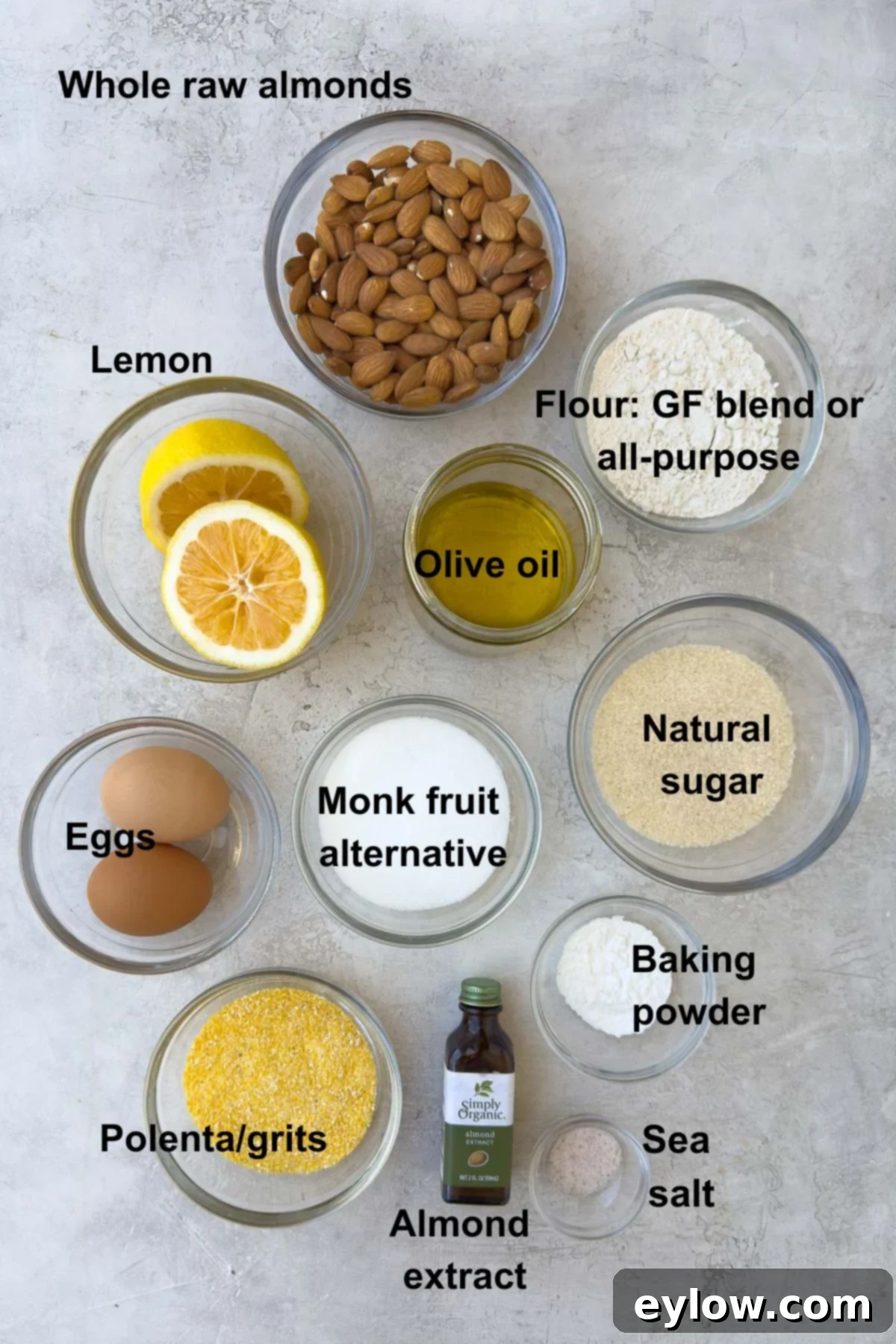
- Polenta (or Cornmeal): This is key to the cake’s characteristic soft crunch. While many bags are labeled “polenta” and “grits,” they are essentially the same — ground cornmeal. It’s important to distinguish this from fine cornmeal flour, which has a different texture. Opt for regular polenta, not instant, as instant varieties are finer and pre-cooked, which can alter the cake’s texture. This is the trusted brand I consistently use for perfect results.
- Flour: To create a delicious **gluten-free lemon olive oil cake**, I recommend using a high-quality general-purpose gluten-free blend. Here is the specific gluten-free flour blend I rely on for my baking. If gluten-free is not a requirement for you, an excellent all-purpose wheat flour will work beautifully. For that, I personally recommend this particular all-purpose flour.
- Baking Powder: This leavening agent is essential for giving the cake its rise and airy texture. Always opt for aluminum-free baking powder for the best flavor, and double-check its expiration date before use. Expired baking powder loses its potency and can lead to a flat cake.
- Salt: A pinch of salt is vital for balancing the sweetness and enhancing all the other flavors in the cake. I prefer fine pink sea salt, but standard table salt will work just as well.
- Almonds: You’ll need raw whole almonds for this recipe. When measuring, weighing them is far more accurate than using volume. By weight, you’ll need approximately 7.5 ounces, which translates to about 1 ¼ cups by measure. Grinding them fresh in the food processor contributes significantly to the cake’s unique texture and nutty depth.
- Sweetener: Granulated sugar, such as cane sugar, is the traditional choice. However, for those looking to reduce sugar content, a blend of granular monk fruit and allulose can be successfully used. I often use a 50/50 mix of cane sugar and a monk fruit blend, and the difference is imperceptible in the final product.
- Lemon: This recipe harnesses the full power of the lemon, using both its zest and juice. Therefore, fresh lemons are non-negotiable for optimal flavor. If you can get your hands on aromatic Meyer lemons, they offer an even sweeter, less acidic citrus note, though regular lemons perform splendidly too.
- Olive Oil: The star of the show! For the best flavor and healthy fat content, always use extra virgin olive oil. Select a mild, fruity variety to complement the lemon without overpowering it. Avoid substituting with vegetable oil, as it lacks the complex flavor and health benefits that olive oil brings to this particular cake.
- Milk: This recipe is incredibly adaptable and works wonderfully with both dairy milk and plant-based alternatives like almond milk. If you’re using homemade, unstrained almond milk, remember to strain it for this recipe to ensure a smooth batter consistency.
- Eggs: Large, clean, and un-cracked eggs are essential binders and provide structure to the cake.
- Almond Extract: While optional, a touch of almond extract truly amplifies the almond flavor from the ground nuts, adding another layer of aromatic depth to this marvelous lemony cake.
For precise measurements of each ingredient, please refer to the comprehensive recipe card located further down the page.
Chef’s Tip: What is the most accurate way to measure in baking? Baking is a precise science, and accuracy is paramount for consistent results. Using a digital kitchen scale is unequivocally the most accurate method for measuring ingredients by weight. Unlike volume measurements (cups and spoons), which can vary significantly depending on how ingredients are packed, a digital scale ensures exact quantities. This inexpensive and invaluable kitchen tool will guarantee that your **lemon olive oil cake** (and all your other baking endeavors) turns out perfectly every single time, making it a worthy investment for any home baker.
Substitutions and Creative Variations
While this **almond and cornmeal cake** recipe is fantastic as is, a few thoughtful substitutions and variations can adapt it to different dietary needs or simply offer a fresh twist. One possibility I haven’t personally tested, but which could theoretically work, is swapping almond flour for whole raw almonds. Since the recipe utilizes a food processor to finely grind the whole almonds directly into the batter, there’s little practical reason to make this change unless you specifically desire to experiment. If you choose to try it, substitute 7.5 ounces of almond flour (roughly 2 cups plus 3 tablespoons) for the whole raw almonds. Again, for precision, it’s always best to weigh it with a digital kitchen scale to ensure the correct consistency.
For a truly vegan lemon cake, you’ll need to replace the eggs. There are several effective egg substitutes available for baking. Consider using flax eggs (1 tablespoon ground flaxseed mixed with 3 tablespoons water per egg), aquafaba (the liquid from a can of chickpeas, whipped), or chia seed eggs. Each option behaves slightly differently, so I highly recommend consulting this helpful guide on egg substitutes for baking to find the best fit for your preferences and ensure your **dairy-free cake** is a success.
To enhance the cake further, especially when serving a special dessert, consider pairing your **lemon olive oil cake** with an additional delightful sauce. This homemade strawberry coulis recipe makes for a terrific, vibrant accompaniment, adding both color and a burst of fruity freshness that complements the lemon beautifully.
Step-by-Step Baking Instructions for Your Lemon Olive Oil Cake
One of the true beauties of this **easy lemon olive oil cake** is how simple the process is, thanks in large part to the efficiency of a food processor. It truly does most of the heavy lifting for you! Before you begin, ensure you have a 9-inch springform pan and some parchment paper ready. These step-by-step photos will guide you through the process, showing you exactly what each stage should look like for a perfect bake.
Set-up for Success: Begin by preheating your oven to a moderate 325°F (160°C). Prepare your 9-inch springform pan by generously spraying it with a non-stick cooking spray (I find this brand to be particularly effective). Then, place a round of parchment paper neatly at the bottom of the pan. This crucial step prevents sticking and makes for easy release later.
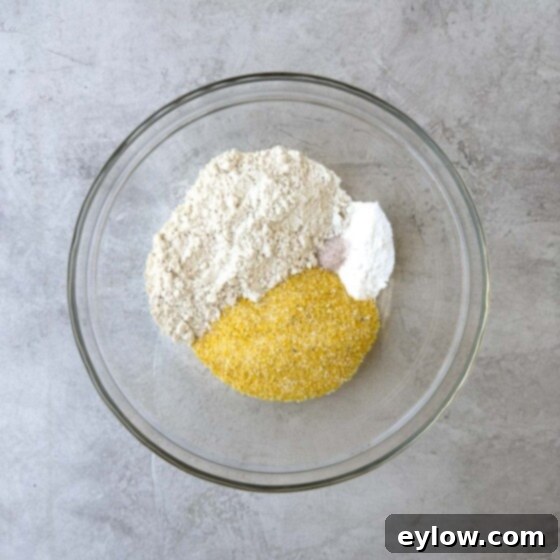
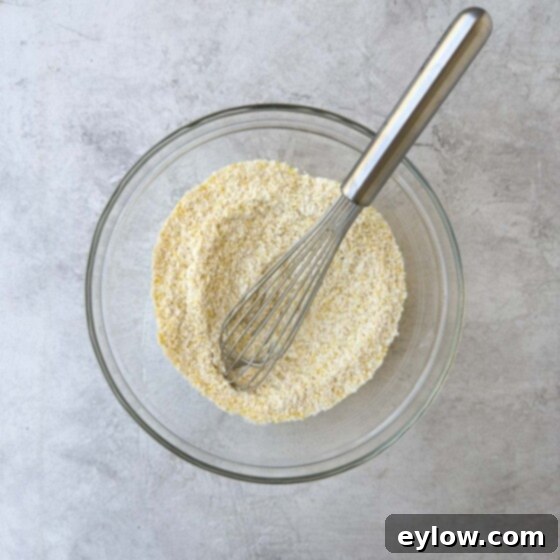
Step 1: Combine Dry Ingredients. In a medium-sized bowl, whisk together the cornmeal (or polenta), your chosen flour (gluten-free or all-purpose), baking powder, and salt. Whisking ensures these ingredients are evenly distributed, which is vital for a consistent rise and texture in your **moist lemon cake**.
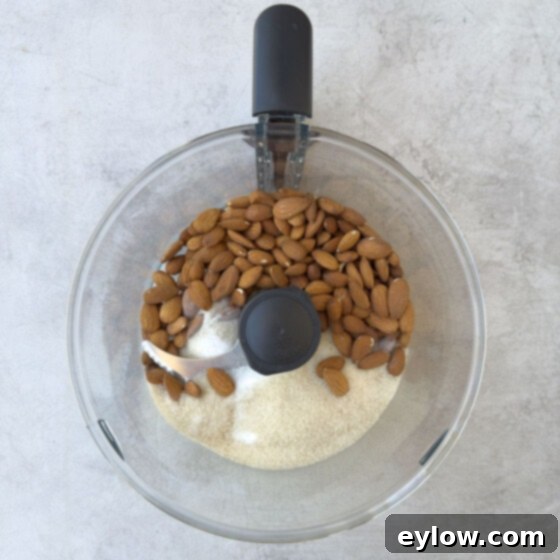

Step 2: Grind Almonds and Sugar. Place the whole raw almonds and sugar into the workbowl of your food processor, fitted with the steel blade. Pulse these ingredients together for approximately 30 seconds. The goal is to achieve a coarse, sandy texture, where the almonds are finely ground but still offer a slight bite. This fresh grinding contributes immensely to the **almond cake** flavor.
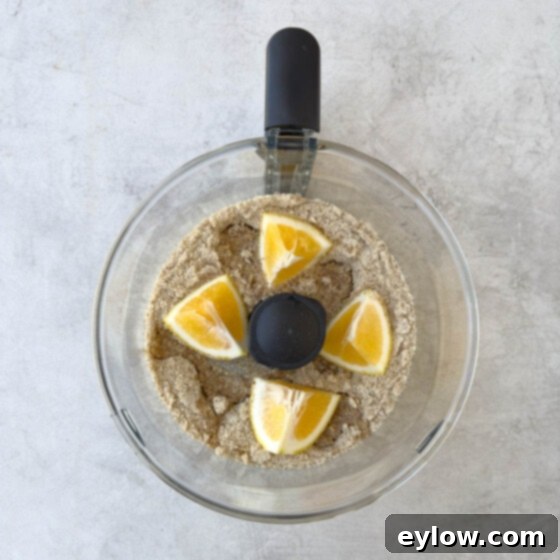
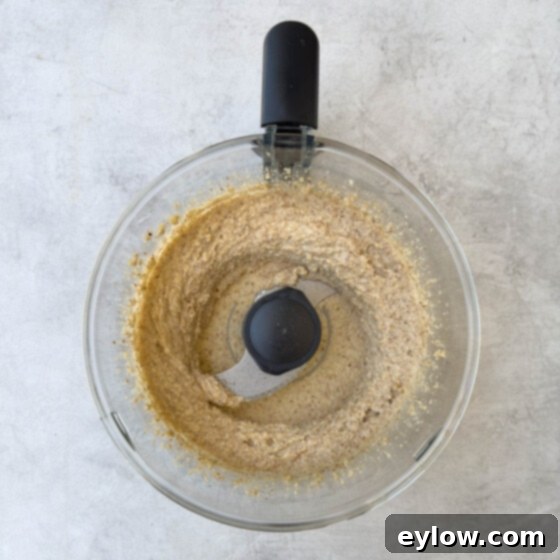
Step 3: Incorporate Lemon. Juice one half of your large lemon to yield about 1 ½ tablespoons of fresh lemon juice; discard the rind. Remove any seeds from the other lemon half, cut it into four small pieces, and add both the lemon juice and the quartered lemon half directly into the food processor with the almond-sugar mixture. Process for a further 45 seconds. This step is crucial for infusing the cake with intense lemon flavor, as the whole lemon is finely ground into the batter. Use a rubber spatula to scrape down the sides of the workbowl, ensuring everything is thoroughly combined.

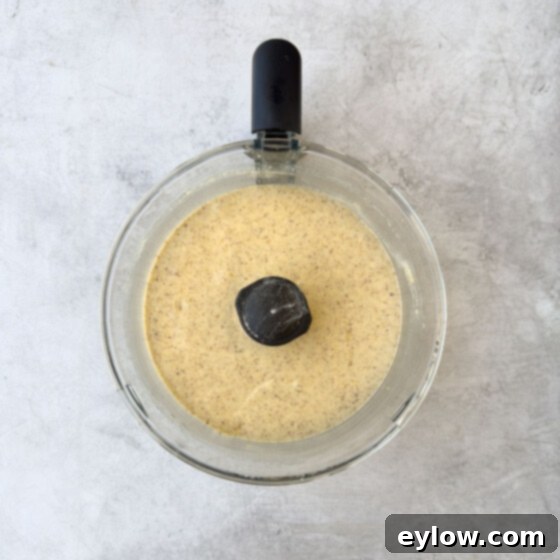
Step 4: Incorporate Wet Ingredients & Finish Batter. Add the extra virgin olive oil, eggs, milk (dairy or almond), and almond extract to the food processor. Process for a full 1 ½ minutes until the batter becomes wonderfully smooth and emulsified. This extended processing time helps to create the cake’s incredibly moist texture. Finally, add the whisked dry cornmeal and flour mixture to the processor and give it just a few quick, long pulses—just enough to combine the dry ingredients without overmixing. Overmixing at this stage can lead to a tough cake.

Step 5: Bake to Golden Perfection. Carefully pour the smooth cake batter into your prepared springform pan. Bake in the preheated oven for 50-60 minutes. The cake is done when the top has achieved a beautiful light golden brown color and springs back gently when lightly touched with your fingertips. Another good indicator is when a cake tester or toothpick inserted into the center comes out with just a few moist crumbs attached, rather than wet batter. Keep in mind that baking times can vary slightly depending on your specific oven. Allow the cake to cool in the pan for 10 minutes; this allows it to set properly before handling. Then, carefully release the spring from the pan and transfer the cake to a wire rack to cool completely. Cooling on a rack ensures air circulation, preventing the bottom from becoming soggy.

A note on oven types: The baking time provided is generally for conventional ovens. If you are using a convection oven, your cake might bake faster due to the circulating hot air. Always keep a close eye on your cake, especially towards the end of the baking cycle. If you have the option, using the conventional mode for this specific recipe is often preferable to ensure even baking without drying out the edges.
Elegant Serving Suggestions and Storage Tips
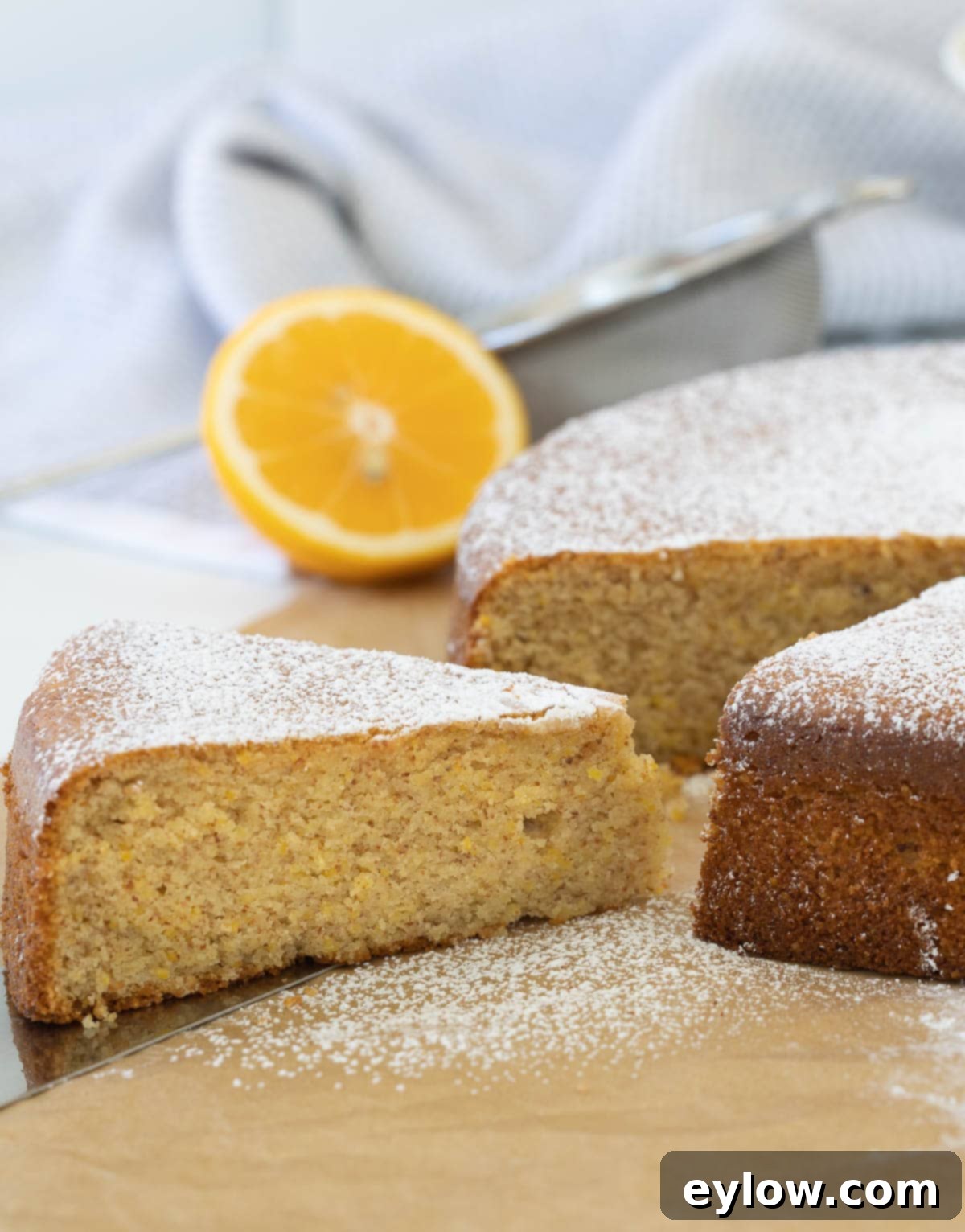
This **lemon olive oil cake** shines in its simplicity, making it incredibly versatile for serving. For a truly elegant yet understated presentation, simply dust the cooled cake with a generous layer of powdered sugar (also known as confectioners’ sugar) or a powdered monk fruit blend for a sugar-reduced option. Its subtle sweetness and tender texture make it a delightful accompaniment to a warm cup of tea or coffee in the afternoon, or a lovely, not-overly-sweet addition to a leisurely brunch spread.
One of the many benefits of this cake is its excellent keeping quality. You can confidently **make it ahead**, up to two days in advance. Once completely cooled, wrap the cake thoroughly in plastic wrap and store it in the refrigerator. This cake maintains its moistness and flavor beautifully for 3-4 days after baking when properly wrapped and refrigerated. While I haven’t personally tested freezing it because it never lasts that long in my home, its dense and moist nature suggests it would likely freeze very well for longer storage, if needed.
How to Dress Up Your Lemon Olive Oil Cake for a Special Occasion
While delicious on its own, this **moist olive oil cake** can be easily transformed into a show-stopping dessert for a special occasion. Elevate its presentation and flavor with these simple yet impactful additions:
- Vibrant Fresh Berries: A scattering of fresh, juicy berries – such as raspberries, blueberries, or sliced strawberries – adds a burst of color, natural sweetness, and a lovely textural contrast.
- An Easy Lemon Glaze or Icing: For an extra layer of lemon flavor and a beautiful sheen, a simple lemon glaze is perfect. This is incredibly easy to make (recipe provided below!) and can be adjusted to your desired consistency and tartness.
- Softly Whipped Cream: A dollop of freshly whipped cream provides a luxurious, creamy counterpoint to the cake’s texture and bright flavor. Sweeten it lightly with sugar and a hint of vanilla extract or, for an extra aromatic touch, almond extract. I often use a squirt of this sugar-free syrup for easy sweetening that blends in seamlessly.
- A Delicious Berry Sauce: For a more gourmet touch, serve slices of cake with a spoonful of this homemade berry sauce, which can be made smooth or left slightly chunky for added texture. It’s an excellent way to introduce another layer of fruitiness and visual appeal.
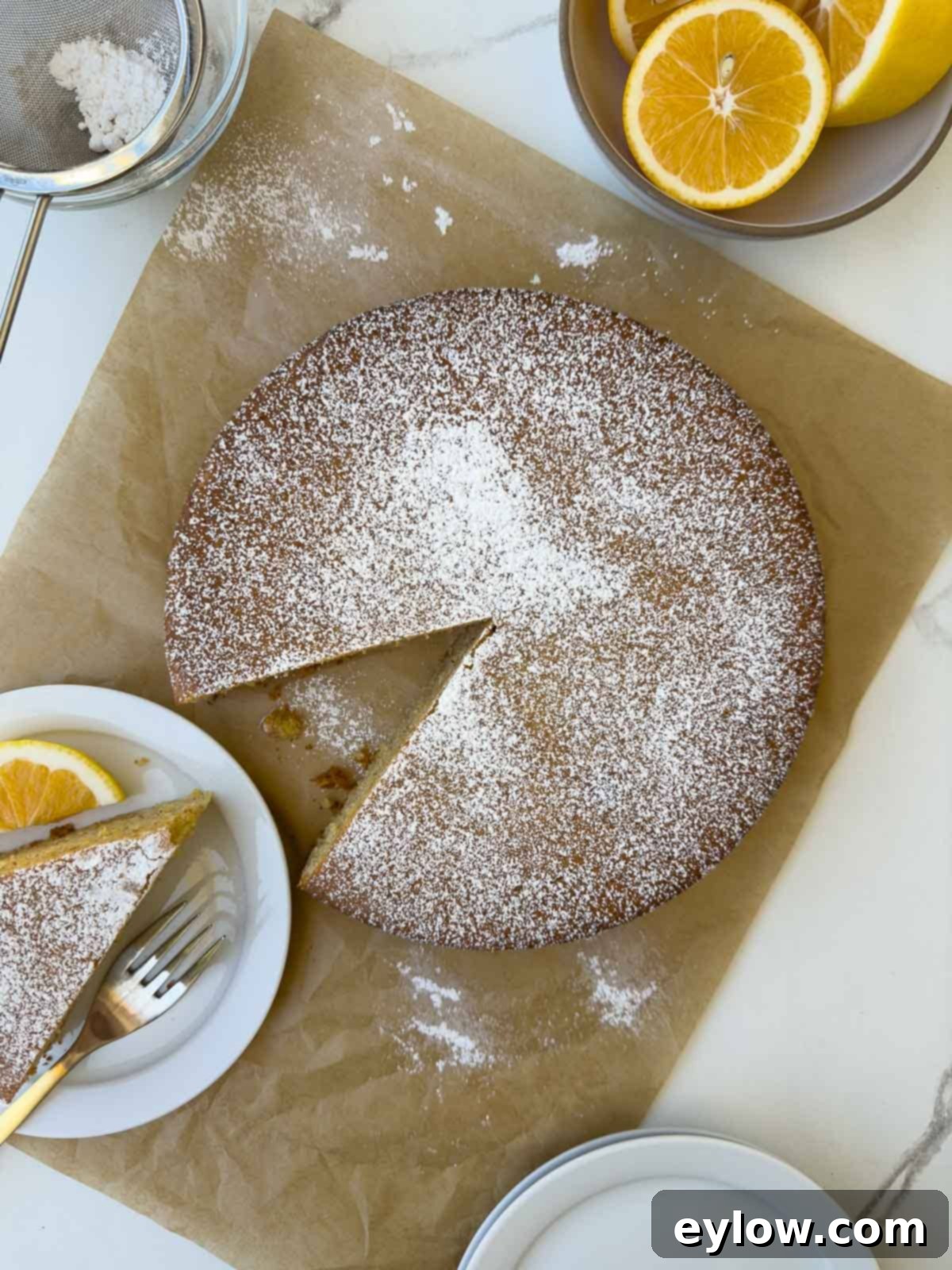
How to Make a Simple Lemon Glaze or Icing
To achieve the beautiful, glossy finish seen in many of the photos, a homemade **lemon glaze** (or lemon icing) is the perfect addition. It’s incredibly simple to prepare and adds another layer of bright citrus flavor to your **lemon olive oil cake**.
To make the glaze, begin with 1 cup of powdered sugar (also known as confectioners’ sugar). It’s crucial to sift the powdered sugar through a fine-mesh sieve or strainer first. This step eliminates any lumps, ensuring a perfectly smooth and pourable glaze. Gradually whisk in fresh squeezed lemon juice, starting with 2 tablespoons and adding more a teaspoon at a time, until you reach your desired consistency. For a thicker, more opaque icing, use less lemon juice. For a thinner, more translucent glaze that drips elegantly, add a bit more. Typically, 2 to 4 tablespoons of lemon juice will be sufficient to achieve the ideal texture.
To subtly reduce the tartness of the glaze, a wonderful trick is to whisk in 1 to 2 tablespoons of melted unsalted butter, whether dairy or plant-based. Taste the glaze first, and then decide if you’d like to mellow out the lemon’s sharpness. The butter also adds a lovely richness and a slightly softer texture to the glaze. If you plan to make the icing ahead of time and refrigerate it, be aware that it will firm up considerably when cold. Simply let it come to room temperature on the counter for a bit, then give it a good re-whisk before serving to restore its smooth consistency.
For an additional layer of complementary flavor, you can also add a little almond extract or vanilla extract to your lemon glaze. Just a quarter to half a teaspoon will enhance the cake’s almond notes, creating an even more harmonious dessert.
For another fantastic gluten-free cake that consistently receives rave reviews, be sure to try my gluten-free pound cake!
Lemon Olive Oil Cake: Frequently Asked Questions
The Lemon Olive Oil Cake offers a delightful sensory experience. It’s wonderfully rich and incredibly moist, with a tender crumb that practically melts in your mouth. You might expect a strong olive oil flavor, but it’s remarkably subtle. Instead, the fruity notes of a good extra virgin olive oil complement the bright, zesty character of the lemon, along with the gentle nuttiness of the almonds and the slight texture from the cornmeal. The overall profile is beautifully balanced, sophisticated, and utterly delicious – a truly unique and memorable flavor.
For an optimal Lemon Olive Oil Cake, selecting the right olive oil is crucial. I consistently recommend using **extra virgin olive oil** due to its superior flavor profile and high quality. However, there’s no need to reach for a particularly fancy, expensive finishing EVOO that you would drizzle over salads. A good quality, everyday extra virgin olive oil with a mild and fruity character is the best choice. This type will enhance the cake’s flavor with its healthy fats and subtle nuances without overpowering the delicate lemon and almond notes.
Yes, oil cakes, like this Lemon Olive Oil Cake, are indeed typically more moist than cakes made with butter. The reason lies in their fat composition. Butter contains a percentage of water (usually around 18%), whereas oil is 100% fat. This higher fat content in oil-based cakes results in a softer, more tender, and noticeably moister crumb. Additionally, oil remains liquid at room temperature, which contributes to a perception of moisture that butter-based cakes, whose butter solidifies when cool, often lack.
The versatility of olive oil cake means it pairs beautifully with a range of toppings, depending on the occasion or your preference. For a simple yet elegant finish, a dusting of powdered sugar (or powdered monk fruit blend for a sugar-free option) sprinkled through a small strainer is perfect. For added indulgence, a dollop of softly whipped cream, lightly sweetened with sugar and flavored with either vanilla or almond extract, is a fantastic choice. Fresh berries, such as raspberries, blueberries, or sliced strawberries, add a burst of color and refreshing tartness. Alternatively, a luscious powdered sugar or powdered monk fruit glaze provides a lovely, tangy coating. Refer to the detailed recipe for how to make this delicious glaze!
More Zesty Lemon Recipes to Brighten Your Day
If you’ve fallen in love with the vibrant flavor of lemon in this olive oil cake, you’re in for a treat! Lemon is an incredibly versatile ingredient that can elevate both sweet and savory dishes. Explore these other fantastic lemon-infused recipes from my kitchen:
- Easy Sugar Free Lemon Curd
- Easy Blender Lemon Chicken Marinade
- Homemade Lemon Custard Ice Cream
- Creamy Lemon Tahini Dressing
⭐️ Did You Make This Recipe? We’d Love to Hear From You!
If you’ve had the pleasure of baking this delicious **lemon olive oil cake**, I would be absolutely thrilled to hear about your experience! Your feedback is invaluable, and I truly enjoy connecting with readers who try my recipes. Please take a moment to add your comment below and share your thoughts. If you loved this recipe and it became a hit in your home, consider leaving it a 5-star rating! Your ratings and reviews truly help other readers discover and enjoy this wonderful dessert. Thank you for your support!
📖 Recipe

Lemon Olive OIl Cake (gluten free)
Sally CameronEquipment
- Food Processor
- Springform pan
- Parchment paper
Ingredients
- ½ cup gluten-free cornmeal/grits 3 ounces
- ½ cup all purpose gluten-free flour blend I use King Arthur’s, 2.4 ounces
- 2 teaspoons aluminum-free baking powder
- ¼ teaspoon table salt
- 7 ½ ounces whole raw almonds 1 ¼ cups
- 1 cup unrefined natural raw sugar OR half or all granular monk fruit/allulose blend
- 1 large lemon
- ¾ cup extra virgin olive oil
- ½ cup unsweetened almond milk or dairy milk
- 2 large eggs
- 1 teaspoon almond extract
Optional Garnishes
- powdered sugar to finish before serving
- fresh berries
- whipped cream
- lemon glaze (icing) recipe below
Instructions
- Pre-heat your oven to 325°F (160°C). Prepare a 9-inch springform pan by spraying it with non-stick spray and lining the bottom with a round of parchment paper. In a medium bowl, thoroughly whisk together the cornmeal, flour, baking powder, and salt.
- In the workbowl of a food processor fitted with a steel knife, add the whole raw almonds and sugar. Pulse for approximately 30 seconds until the mixture has a coarse, sandy texture.
- Cut one large lemon in half. Juice one half to obtain 1 ½ tablespoons of lemon juice; discard the rind and add this juice to the food processor. Remove any seeds from the remaining lemon half, cut it into four pieces, and add these pieces to the food processor as well. Process for 45 seconds to finely incorporate the lemon. Scrape down the sides of the workbowl with a rubber spatula to ensure all ingredients are well combined.Next, add the olive oil, almond milk (or dairy milk), eggs, and almond extract to the food processor. Process for 1 ½ minutes until the batter is smooth and fully emulsified. Finally, add the whisked cornmeal/flour mixture to the food processor and give it just a few quick, long pulses to combine, being careful not to overmix.
- Pour the prepared batter evenly into the lined springform pan. Bake for 50-60 minutes, or until the top is golden brown and feels firm yet still springs back slightly when gently touched. A cake tester or toothpick inserted into the center should come out with only moist crumbs attached. Baking time may vary based on your oven.
- Allow the cake to cool in the pan for 10 minutes. This helps the cake to set and prevents it from crumbling. Then, carefully run a thin-bladed knife around the inner edge of the pan to loosen the cake. Release the spring, remove the bottom of the pan and the parchment paper, and transfer the cake to a wire rack to cool completely. Once fully cooled, serve as desired with fresh berries, whipped cream (dairy or coconut milk-based), a simple dusting of powdered sugar, or the optional lemon glaze (recipe below). The cake stores well for up to two days when wrapped tightly in plastic wrap and refrigerated.
